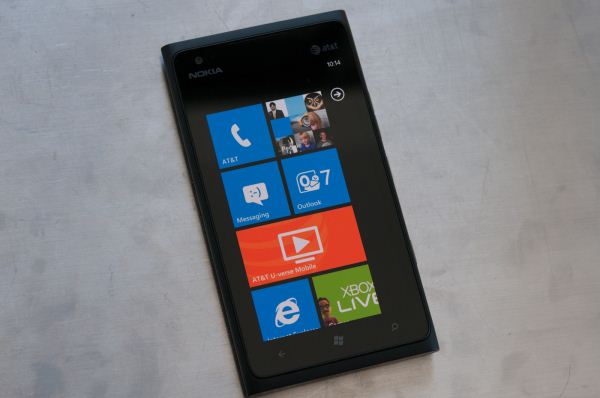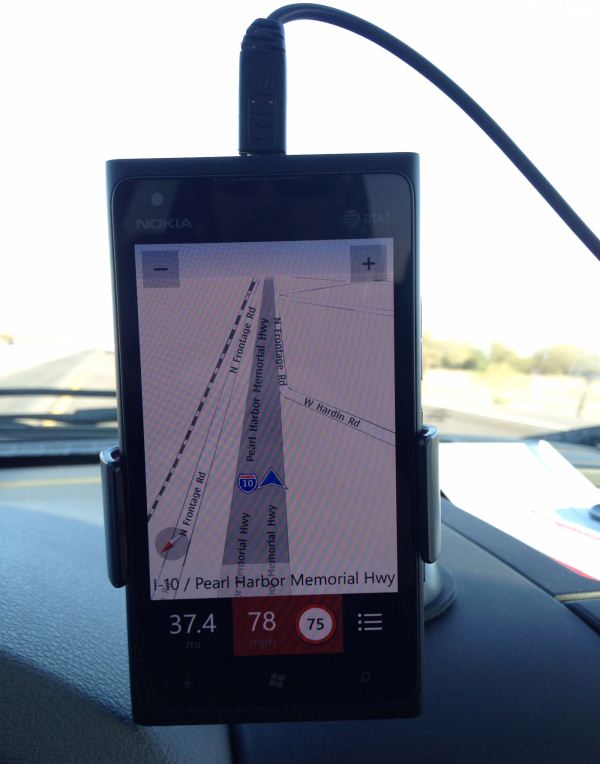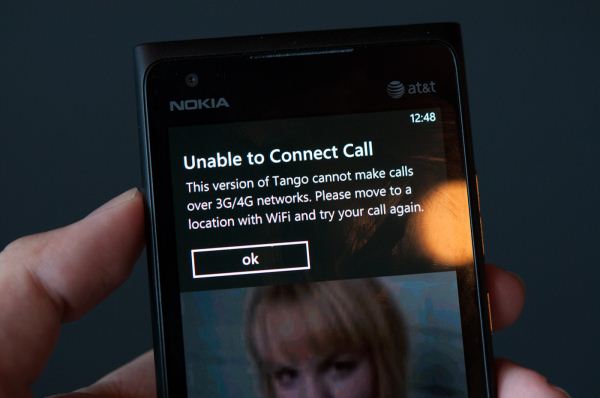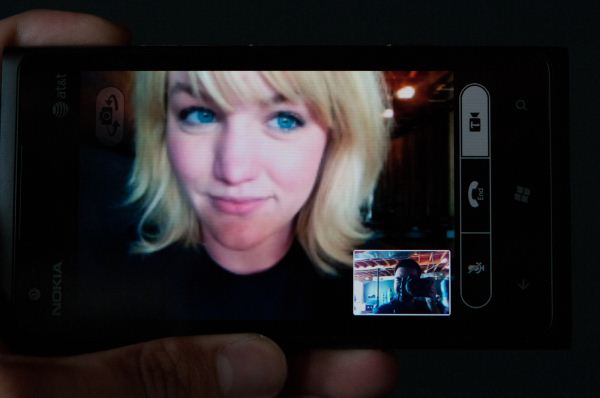Nokia Lumia 900 Review - Windows Phone with LTE
by Brian Klug on April 3, 2012 9:00 PM ESTWP7.5 and Preloaded Applications
To accommodate the Lumia 900’s unique inclusion of LTE, the device runs a newer build of WP7.5 Mango than I’ve seen on any other devices. Our sampled Lumia 900 came running 7.10.8112.7. Superficially I can’t find anything major which deviates from the WP7.5 I’ve seen on numerous other devices, other than again small changes to accommodate LTE. These boil down to inclusion of an LTE status indicator and an according change to the cellular settings page to select between EDGE / WCDMA (3G) / LTE (4G) - more on this later. We’ve gone over Windows Phone 7.5 Mango before, and what’s shipped on the Lumia 900 isn’t different from what has come before, obviously. Nokia’s input into the WP7.5 UI seems to go as far as their customized ringtones, a “Nokia Blue” theme, and the usual customization options for OEMs such as the right options under camera, marketplace link, and so forth.
As with any carrier-subsidized phone, there’s some software preload on the Lumia 900. The stuff that comes preinstalled on the Lumia 900 matches what I’ve seen on other AT&T-branded WP7 devices, namely AT&T Code Scanner, Navigator, Radio, U-Verse Mobile, an ESPN app, and YPmobile seem to be the bloat. What’s great about WP7 is that you can uninstall any of these preloaded applications and never have to see them again.
Oddly enough the only Nokia software among the preloads is the Nokia App Highlights application. The Marketplace includes a Nokia Collection shortcut as you’d expect, but there’s no preloaded Nokia Drive or Maps unless you go in the Marketplace and grab it. That’s a bit odd, but I suspect AT&T’s ulterior motive here is that it wants subscribers to use its own AT&T Navigator application (which requires a monthly subscription) rather than the free-because-it’s-a-Lumia Nokia Drive application.
I have to say that I’m impressed with how much Nokia Drive has improved since its initial launch on Windows Phone 7 with the Lumia 800. As of this writing the version is 2.0.0.2148, and it feels much more polished and responsive now since last I used it, and includes a few new features. The current version still requires you to preload maps for the regions you want over WiFi (so be sure you do this before getting in the car), but you basically get the ability to pre-cache whatever maps you want instead of hoping you have network connectivity where you’re going like with Google Navigation.
I took a small road trip up to Phoenix to test AT&T LTE and used the Lumia 900 and Nokia Drive for navigation the whole way. Again, the application feels more performant and some places where the UI had a ton of friction have been smoothed over. One of the new Nokia Drive features is showing current speed and the road’s speed limit alongside, among other things. At this point the only major gripes I have with Nokia Drive are that the application arguably should change between night and daytime map colors automatically, and that the accelerometer filtering seems to misinterpret bumps in the road as a rotation occasionally.
Nokia’s Maps application is up to version 1.3.10.230 and is still a good alternative to the default Windows Phone Maps application. Like Nokia Drive, I find it unfortunate that the application isn’t installed by default.
One of the other major preloads is Tango, a cross platform voice calling application which runs on Windows, iOS, Android, and WP7. One of Tango’s big features is that voice calling is supported 3G, 4G, and WiFi, however curiously enough the preinstalled version of Tango on the Lumia 900 doesn’t support calling over 3G or 4G cellular data.
Obviously this is an AT&T imposed restriction imposed on their subsidized hardware (at least for this variant), however it’s just annoying. I installed the marketplace version of Tango, however, which does allow calling over cellular data. This does work - again it seems pointless for AT&T to preload a version of Tango which undermines that service’s principle feature, especially when you can nuke the preloaded version in 10 seconds and install the market version without the limitation.
Regardless, I gave Tango voice calling a shot over WiFi and 3G to an iPhone client on 3G using the preinstalled application, and it does work well on the Lumia 900. The interface for Windows Phone 7 approximates the FaceTime interface, including the same front to back camera switcher overlay. At the bottom are controls for muting audio, enable/disable video, and ending the call. I can’t complain about quality, which looks about what you’d expect (perhaps QVGA or slightly higher) for a video encoded and sent over 3G data.















128 Comments
View All Comments
RaistlinZ - Tuesday, April 3, 2012 - link
2010 would have liked this phone.guidryp - Tuesday, April 3, 2012 - link
Yeah, why are they getting a pass on a single core phone with abysmal browser performance as their flagship offering.hemmy - Wednesday, April 4, 2012 - link
Abysmal? Please. Yes the benchmarks are poor but the browsing experience is significantly better than any Android phone with the sheer smoothness.eddman - Wednesday, April 4, 2012 - link
I was watching a video the other day, showing scrolling and zooming in verge and engadget, which are very heavy websites, and was really surprised by how much fast and smooth WP is when it comes to browsing.I don't suppose a single-core android phone can be that smooth.
Braumin - Wednesday, April 4, 2012 - link
Because life isn't about benchmarks.juhatus - Wednesday, April 4, 2012 - link
Totally wrong. Life is a benchmark.Now I need my milliseconds back.
PeteH - Thursday, April 5, 2012 - link
But without something to measure myself against, how will I know if I'm winning?TGressus - Wednesday, April 4, 2012 - link
2010 would have used a browser.p~
Seriously though, when you have to zoom and pan to view content, doesn't it feel like you are using the wrong device to begin with?
jwcalla - Tuesday, April 3, 2012 - link
As a software developer I can say that I've had nothing but heartache dealing with Qualcomm hardware so far. Closed-up proprietary stuff with no public API to help us out seems to be the preferred mode of operation.Ultimately a platform comes down to its developers. There are a limited number of developers and the platform that attracts the most and best from the lot is going to provide the greatest user experience. Apple figured this out long ago in the device space. Microsoft before that on the desktop. If Nokia and Microsoft understand this today, they'll do well.
I don't care how well the hardware benchmarks, we need to be treated as something other than an afterthought if you want us to develop for your platform.
Braumin - Wednesday, April 4, 2012 - link
I'm sorry how is Visual Studio not the best for developers? Are you trying to write native code to WP7? I know it can be done, but most apps don't do it.I think the developer tools are top notch for WP7.5. Sure, there are some holes to fill (WP8) but they will get filled.